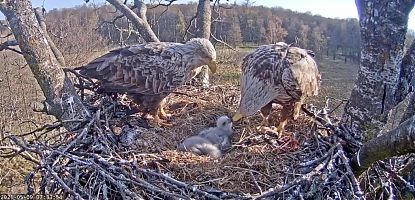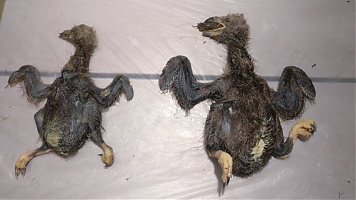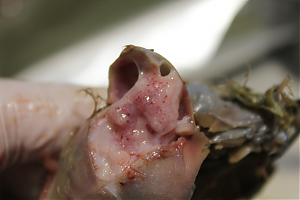The cause of death for the white-tailed eagle chicks was avian influenza H5N1
19.05.2011 | Rubriik: Veebikaamerad
Estonian University of Life Sciences (19.05.2021 )
An autopsy performed at the Estonian University of Life Sciences revealed that the white-tailed eagle chicks in the nesting camera in Matsalu National Park died because of the H5N1 avian influenza (bird flu).
According to the veterinarian Madis Leivits, who determined the cause of death, the eagle chicks were infected with an aggressive strain of bird flu that has not been encountered in Estonia before. H5N1 is a highly contagious and dangerous strain of bird flu that has been known to infect mammals, including humans.
Man’s desire to experience nature as closely as possible is inherent. For a long time now, one such option has been real-time nest cameras, which allow to experience the joys and sorrows of birds without disturbing their breeding. According to scientists, nature cameras have a much broader function also, helping us to understand the life and needs of animals in nature, through which we can better coexist in a common living environment.
The white-tailed eagle nest camera located in Matsalu National Park and installed by MTÜ Kotkaklubi is extremely popular both in Estonia and abroad. The most joyful events took place on April 28 and 30, when the eagle chicks hatched. The new-borns were cared for by adult birds, offering them a variety of food (fish, game carcasses and waterfowl).
Last week, however, the nest was hit by an accident: the chicks suddenly became powerless and died on consecutive days at the age of about two weeks. The case raised many questions among nest camera viewers and bird researchers, so it was decided to investigate further the cause of the chicks’ deaths. MTÜ Kotkaklubi, Estonian University of Life Sciences and the Environmental Board coordinated the collection of dead chicks and remains from the nest and transport to Tartu to the Institute of Veterinary Medicine and Animal Husbandry of the EEC.
According to the veterinarian Leivits, at the initial examination, the older chick (EE1) had a rather large rump in his throat (parts swallowed with indigestible food are usually vomited out). The hump, which consisted mainly of hay, was also in the roots of the smaller chick’s (EE2) throat. Whether this is normal, we do not know yet, said Leivits.
The autopsy found that most of the tissues in the bodies of the chicks were altered. The organs were fluffy and abnormally coloured. Bruises from various tissues could also be found and the lungs were filled with mucous foaming fluid.
Preliminary tests were positive for family A influenza virus. To confirm and type the finding, a sample of the lungs was sent to the Veterinary and Food Laboratory, where the H5N1 avian influenza virus was confirmed.
The disease probably reached the nest with waterfowl, which were brought as food by the adults. Waterfowl are also a natural reservoir for influenza, Leivits noted, confirming that this is a natural process in nature and that diseases are also part of nature. „This strain of influenza has not been found in Estonia before, which does not mean that it has not occurred in our nature before,” Leivits stated.
He hoped that the adult birds, which ate the same food as the eagle chicks, would be able to survive the disease and be able to raise their chicks again next year and.
Avian influenza H5N1 is also important from a human health perspective. Namely, the virus has the ability to spread and adapt quickly, crossing barriers between species, including hitting humans and other mammals. „This finding reminds us of caution and the fact that incompetent intervention can endanger our own health,” says Leivits.
The spread of diseases plays an important role in humans through their activities in the environment, directly in the transport of viruses or in the alteration of the living environment, as a result of which pathogens spread more successfully, or the resistance of animals is inhibited.



